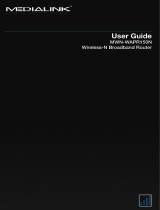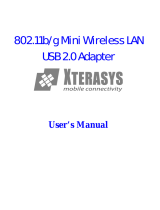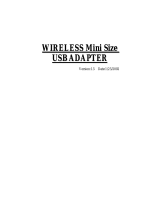Page is loading ...

I
User Guide
MWN-USB54G 802.11 b/g Wireless USB Adapter
2.4GHz Rev: 1.0.0

II
COPYRIGHT & TRADEMARKS
Specifications are subject to change without notice.
is a registered trademark of
MEDIALINK PRODUCTS, LLC. Other brands and product names are trademarks or registered
trademarks of their respective holders.
No part of the specifications may be reproduced in any form or by any means or used to make any
derivative such as translation, transformation, or adaptation without permission from MEDIALINK
PRODUCTS, LLC. Copyright © 2007 MEDIALINK PRODUCTS, LLC
All rights reserved.
http://www.medialinkproducts.com

III
FCC STATEMENT
This equipment has been tested and found to comply with the limits for a Class B digital device, pursuant
to part 15 of the FCC Rules. These limits are designed to provide reasonable protection against harmful
interference in a residential installation. This equipment generates, uses and can radiate radio frequency
energy and, if not installed and used in accordance with the instructions, may cause harmful interference
to radio communications. However, there is no guarantee that interference will not occur in a particular
installation. If this equipment does cause harmful interference to radio or television reception, which can
be determined by turning the equipment off and on, the user is encouraged to try to correct the
interference by one or more of the following measures:
Reorient or relocate the receiving antenna.
Increase the separation between the equipment and receiver.
Connect the equipment into an outlet on a circuit different from that to which the receiver is
connected.
Consult the dealer or an experienced radio/ TV technician for help.
This device complies with part 15 of the FCC Rules. Operation is subject to the following two conditions:
1) This device may not cause harmful interference.
2) This device must accept any interference received, including interference that may cause
undesired operation.
Any changes or modifications not expressly approved by the party responsible for compliance could void
the user’s authority to operate the equipment.
FCC RF Radiation Exposure Statement
This device has been tested for compliance with FCC RF Exposure (SAR) limits in the typical laptop
computer configuration and this device can be used in desktop or laptop computers with side mounted
PCMCIA slots. This device cannot be used with handheld PDAs (personal digital assistants). This device
and its antenna must not be co-located or operated in conjunction with any other antenna or transmitter.
CE Mark Warning
This is a class B product. In a domestic environment, this product may cause radio interference, in which
case the user may be required to take adequate measures.
National Restrictions

IV
2400.0-2483.5 MHz
Country Restriction Reason/remark
Bulgaria
General authorization required for outdoor use and
public service
France
Outdoor use limited to 10
mW e.i.r.p. within the band
2454-2483.5 MHz
Military Radiolocation use. Refarming of the 2.4 GHz
band has been ongoing in recent years to allow current
relaxed regulation. Full implementation planned 2012
Italy
If used outside of own premises, general authorization is
required
Luxembourg None
General authorization required for network and service
supply(not for spectrum)
Norway Implemented
This subsection does not apply for the geographical area
within a radius of 20 km from the centre of Ny-Ålesund
Russian Federation
Only for indoor applications

V
Package contents
The following contents should be found in your box:
One MWN-USB54G 54M Wireless USB Adapter
One USB extension cable
One MWN-USB54G 54M Wireless USB Adapter Resource CD, including:
Drivers and Utility
User Guide
Other Helpful Information
Note:
If any of the listed contents are damaged or missing, please contact the retailer from whom you
purchased the product for assistance.

VI
CONTENTS
Chapter 1 Introduction .......................................................................................... 1
1.1 Product Overview……………………………………………………………………………………..1
1.2 Main Features…………………………………………………………………………………………1
1.3 LED Status…………………………………………………………………………………………….1
Chapter 2 Installation Guide ................................................................................ 2
2.1 Software Installation…………………………………………………………………………………..2
2.1.1
Overview ........................................................................................................................ 2
2.1.2 Installation for Windows 2000 ......................................................................................... 2
2.1.3 Installation for Windows Vista ......................................................................................... 4
2.2 Uninstall Software……………………………………………………………………………………..9
2.2.1
Uninstall the driver software from your PC ..................................................................... 9
2.2.2 Uninstall the utility software from your PC ...................................................................... 9
Chapter 3 Configuration ..................................................................................... 10
3.1 Configuration of Utility……………………………………………………………………………….10
3.1.1
Profile ........................................................................................................................... 10
3.1.2 Add or Edit a Configuration Profile ............................................................................... 11
3.1.3 Link Status ................................................................................................................... 13
3.1.4 Site Survey ................................................................................................................... 14
3.1.5 Statistics ....................................................................................................................... 15
3.1.6 Advanced ..................................................................................................................... 16
3.1.7 About ............................................................................................................................ 17
3.1.8 An example for application ........................................................................................... 18
3.2 Configuration for windows Vista……………………………………………………………………18
Appendix A:Glossary ............................................................................................. 21
Appendix B:Specifications .................................................................................... 23
Appendix C: Contact Information .......................................................................... 24

MWN-USB54G 54M Wireless USB Adapter User Guide
- 1 -
Chapter 1 Introduction
1.1 Product Overview
The MWN-USB54G 54M Wireless USB Adapter is a USB 2.0 pen-size wireless adapter
supporting IEEE 802.11b/g 2.4GHz radio operation. It provides high-speed wireless connection
with data rate up to 54Mbps. Additionally, wireless roaming allows the user to move among
different AP without losing the current connection. The adapter provides excellent security
features including:TKIP, AES, WPA, and up to 128 bit WEP encryption security make the network
almost impenetrable.
Featuring high performance transmission rates, simple installation and adaptability, as well as
strong security the MWN-USB54G 54M Wireless USB Adapter is the perfect solution for small
office and home needs.
1.2 Main Features
Complies with IEEE802.11g, IEEE802.11b standards
Supports WPA data security, IEEE802.1x authentication, TKIP/AES encryption, 64/128-bit
WEP encryption
Supports 54/48/36/24/18/12/9/6Mbps or 11/5.5/2/1Mbps wireless LAN data transfer rates
Provides USB interface
Supports Ad-Hoc and Infrastructure modes
Supports roaming between access points when configured in Infrastructure mode
Eases configuration and provides monitoring information
Supports Windows 98SE, Me, 2000, XP , Vista
Internal Antenna
1.3 LED Status
The LED on the top of this card indicates Link/Act status. It blinks at green light when sending and
receiving data.

MWN-USB54G 54M Wireless USB Adapter User Guide
- 2 -
Chapter 2 Installation Guide
2.1 Software Installation
2.1.1 Overview
The Setup Wizard will quickly and easily guide you through the installation of your Wireless USB
Adapter. For Windows 98SE, ME, 2000 and XP, please see section 2.1.2 below. For Vista
installations, please see section 2.1.3 on page 4 of this user guide.
2.1.2 Installation for Windows 98SE. ME, 2000 and XP
1. Insert the Resource CD into your CD-ROM drive. If autorun is enabled on your computer,
the welcome page (Figure 2-1) should appear automatically. If the welcome page does not
appear automatically, navigate to the drive containing the CD and double click the drive that
contains the resource CD named “MU001CD”, then double click on the executable file named
“Autorun”.
2. Click Install Software to start the Utility and Driver installation.
Figure 2-1

MWN-USB54G 54M Wireless USB Adapter User Guide
- 3 -
3. The Install Shield Wizard screen will appear (Figure 2-2). Click “Next” to continue.
Figure 2-2
4. After the files have been successfully copied, the screen in Figure 2-3 will appear. Click the
Finish button to finish the wizard.
Figure2‐3
5. HARDWARE INSTALLATION- Connect one end of the USB cable to the Adapter.
6. Connect the other end of the USB cable to the USB port on your computer. Because the
Adapter gets its power from the host, there is no external power supply. The LED should light
up when the Adapter is plugged in and the PC is on.

MWN-USB54G 54M Wireless USB Adapter User Guide
- 4 -
2.1.3 Installation for Windows Vista
After you complete the hardware installation, follow the steps below in order to install the
MWN-USB54G Wireless USB Adapter drivers for Windows Vista:
1. HARDWARE INSTALLATION- Connect one end of the USB cable to the Adapter.
2. Connect the other end of the USB cable to the USB port on your computer. Because the
Adapter gets its power from the host, there is no external power supply. The LED should light
up when the Adapter is plugged in and the PC is on.
3. Insert the Resource CD into your CD-ROM drive, right-click the Computer icon as shown in
the 2-4, select the Properties.
Figure 2-4 Begin installation for Windows Vista

MWN-USB54G 54M Wireless USB Adapter User Guide
- 5 -
4. Select Device Manager as shown in Figure 2-5, then select Continue in the next screen.
Figure 2-5 Select Device management

MWN-USB54G 54M Wireless USB Adapter User Guide
- 6 -
5. Right-click the adapter icon “54M.USB...”, and select “Update Driver Software” to proceed.
Figure 2-6 Driver management
6. Select the method to update the driver software (see Figure 2-7). If you want the system to
search the software automatically, select the first type. Otherwise select “Browse my
computer for driver software” to install the software (best way).
Figure 2-7 Select the method to install

MWN-USB54G 54M Wireless USB Adapter User Guide
- 7 -
7. Click the Browse button in the next screen to select the file which contains the driver
software for the adapter. After that, click Next to proceed.
Figure 2-8 Select the driver software
Note:
Vista X86 is designed for the Vista of 32bit, Vista X64 is designed for the Vista of 64bit, please
select according as you need.
8. After that, the installation will proceed as shown in Figure 2-9.
Figure 2-9 Installing

MWN-USB54G 54M Wireless USB Adapter User Guide
- 8 -
Note:
During the installation, you will see the warning box as shown in figure 2-10, please select “Install
this driver software anyway” to proceed.
Figure 2-10 warning for security
9. Finally, the installation will complete, you will see the next screen below, click Close to
complete.
Figure 2-11 Complete the installation

MWN-USB54G 54M Wireless USB Adapter User Guide
- 9 -
2.2 Uninstall Software
2.2.1 Uninstall the driver software from your PC
1. On the Windows taskbar, click the Start button, point to Settings, and then click Control
Panel.
2. Double-click the System icon, click on the Hardware tab in the System window.
3. Click on the Device Manager button, double-click Network Adapters, and then right-click
MWN-USB54G Wireless USB Adapter.
Figure 2-1 Uninstall Driver
4. Click Uninstall..., shown in above Figure 2-1, the system will uninstall the driver software of
the adapter from your PC.
2.2.2 Uninstall the utility software from your PC
1. On the Windows taskbar, click the Start button, point to Settings, and then click Control
Panel
2. Double-click the Add/Remove Programs icon, find the MWN-USB54G program from the
installed program list, highlight it and click the Remove button.
3. Following the Install Shield Wizard will uninstall the utility software from your PC.
Note:
MWN-USB54G
don’t have utility for windows Vista, so you should follow the section 2.3.1 to
uninstall the driver software from your PC.

MWN-USB54G 54M Wireless USB Adapter User Guide
- 10 -
Chapter 3 Configuration
3.1 Configuration of Utility
MEDIALINK MWN-USB54G Wireless USB Adapter can be configured by its utility for Windows
98SE, ME, 2000, XP. This section describes how to configure your Wireless USB Adapter for
wireless connectivity on your Wireless Local Area Network (WLAN) and use the data security
encryption features.
After the Adapter's driver and utility has been installed, the adapter’s tray icon,
or , will
appear in your system tray. It means the utility is running on your system. If the utility does not run,
you can run the utility by clicking: Start> Program> MEDIALINK> MWN-USB54G WIRELESS
UTILITY> MWN-USB54G Wireless Utility. If the icon still does not appear, the driver or utility
may be installed incorrectly or the adapter is unplugged, please try again.
Icon
means the connection has been established. Icon means there is no connection.
Double-click the
icon and the configuration screen of the utility will appear. You can also run
the utility by clicking: Start> Program> MEDIALINK> MWN-USB54G WIRELESS UTILITY>
MWN-USB54G Wireless Utility. The utility provides a complete and easy to use set of tools to:
Display current status information
Edit and add configured profiles
Display current diagnostics information
The section below introduces these above capabilities.
Note:
If your OS is Windows XP, you can use Windows XP to configure the wireless network settings.
(To use this function, you must upgrade the OS with sp1).
If you want to use Windows XP to configure wireless network settings, just exit the utility.
Right-click the icon
at the bottom of the screen, and click Exit to exit the utility.
3.1.1 Profile
Click the Profile tab of the utility and the Profile screen will appear, Figure 3-1. The Profile
screen provides tools to:
Add a Profile
Delete a profile
Edit a profile
Activate a profile

MWN-USB54G 54M Wireless USB Adapter User Guide
- 11 -
Figure 3-1 Profile Tab
To create a new profile, click the Add button on the Profile tab, the Profile configuration screen
will appear as shown in Figure 3-2.
To edit a profile, highlight the desired profile name on Profile Name list, and click the Edit button,
the Profile configuration screen will appear shown in Figure 3-1.
To delete a profile, highlight the desired profile name on Profile Name list, and click the Delete
button.
To switch to another profile, highlight the desired profile name on Profile Name list, and click
the Activate button.
Note:
Do not forget to click the Apply button when you create a new profile for connection.
3.1.2 Add or Edit a Configuration Profile
To add a new configuration profile, click Add button on the Profile Management tab. To modify a
configuration profile, select the configuration from the Profile list and click Edit.
The Profile Management dialog box will display a screen similar to that shown in Figure 3-2.
1. Edit the Configuration tab

MWN-USB54G 54M Wireless USB Adapter User Guide
- 12 -
Profile Name - Identifies the configuration profile. This name must be unique. Profile names
are not case-sensitive.
SSID - The IEEE 802.11 wireless network name. This field has a maximum limit of 32
characters.
PSM(Power Save Mode)
CAM(
Constantly Awake Mode) – Continuous Access Mode.
PSM(Power
Saving Mode) - Power Saving mode.
Network Type – Displays the wireless mode, either Ad-hoc or Infrastructure mode
Preamble – Specifies the preamble setting in 802.11b. The default setting is Auto Switch
(access point mode), which allows both short and long headers in the 802.11b frames. The
adapter can only use short radio headers if the access point supports and uses them.
RTS Threshold – Default is 2312.
Fragment Threshold – Default is 2312.
Ad-hoc mode – Displays the wireless mode, either Only 802.11B or 802.11B/G mode.
Channel – Shows the current channel in use. This field determines which operating
frequency will be used.
Figure 3-2 Add Profile - configuration
2. Edit the Authentication and Security tab

MWN-USB54G 54M Wireless USB Adapter User Guide
- 13 -
Figure 3-3 Add Profile – configuration
Authentication Type – Three options, Open System, Shared-Key System or LEAP.
802.1x Setting – It enables when Authentication Type is setting to WPA.
Encryption – Displays which encryption type that the driver is using. When you select Open
System, Shared-Key System as Network Authentication, there are two options: WEP and
Disabled. If you select WPA-PSK as Network Authentication, there are TKIP and AES
options instead of WEP and Disabled.
Wep Key – Key #1, Key #2, Key #3, Key #4, the Key groups. You can enter 10 hexadecimal
digits (any combination of 0-9, a-f, A-F) or 5 ASCII characters for 64-bit (also called 40bits)
encryption. You can enter 26 hexadecimal digits (any combination of 0-9, a-f, A-F) or 13
ASCII characters for 128-bit (also called 104bits) encryption.
3.1.3 Link Status
The Link Status tab displays the adapter's current status.

MWN-USB54G 54M Wireless USB Adapter User Guide
- 14 -
Figure 3-4 Link Status
The following table describes the items found on the Network Status screen.
Status - Shows whether the station is connected to the wireless network, if not connected,
display RF is closed; if connected, display AP name and BSSID.
Extra Info - Shows link status and the current channel in use.
Link Speed - Shows the current max Transfer rate, unit is Mbit/sec.
Throughput - Displays Tx and Rx rate, unit is Kbits/sec.
Link Quality - Shows the quality of the signal.
Signal Strength - Shows the strength of the signal.
3.1.4 Site Survey
Click the Site Survey tab of the Utility and the Site Survey screen will appear, Figure 3-5. On the
Site Survey screen you can scan the Available Infrastructure and Ad Hoc Networks.
/









